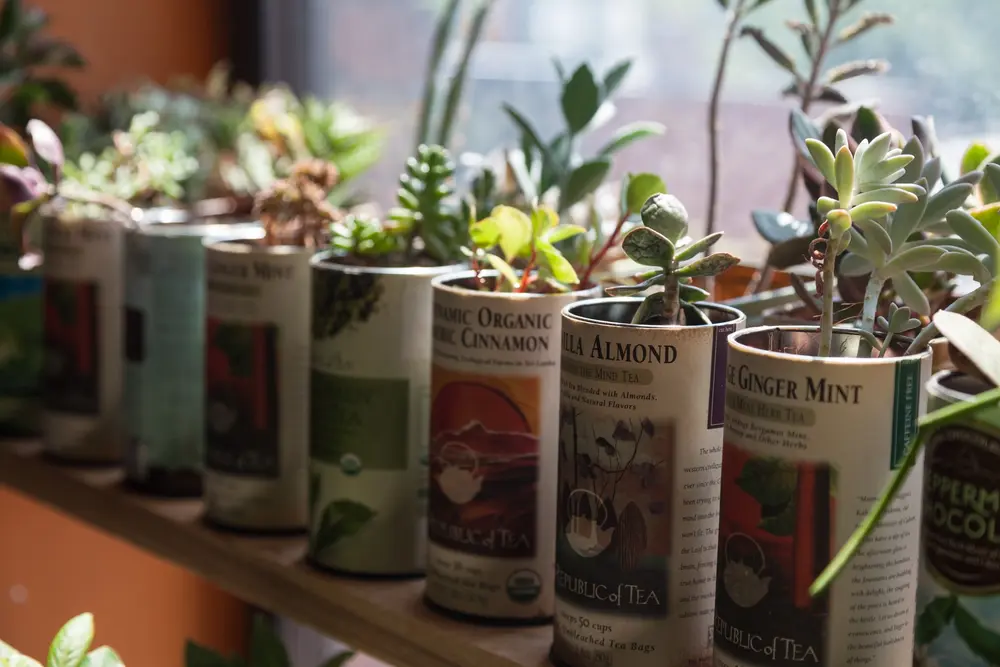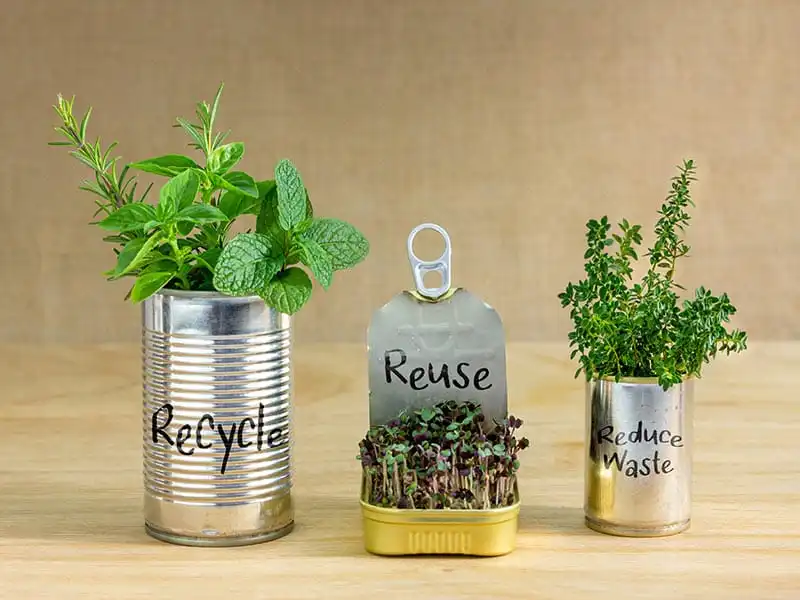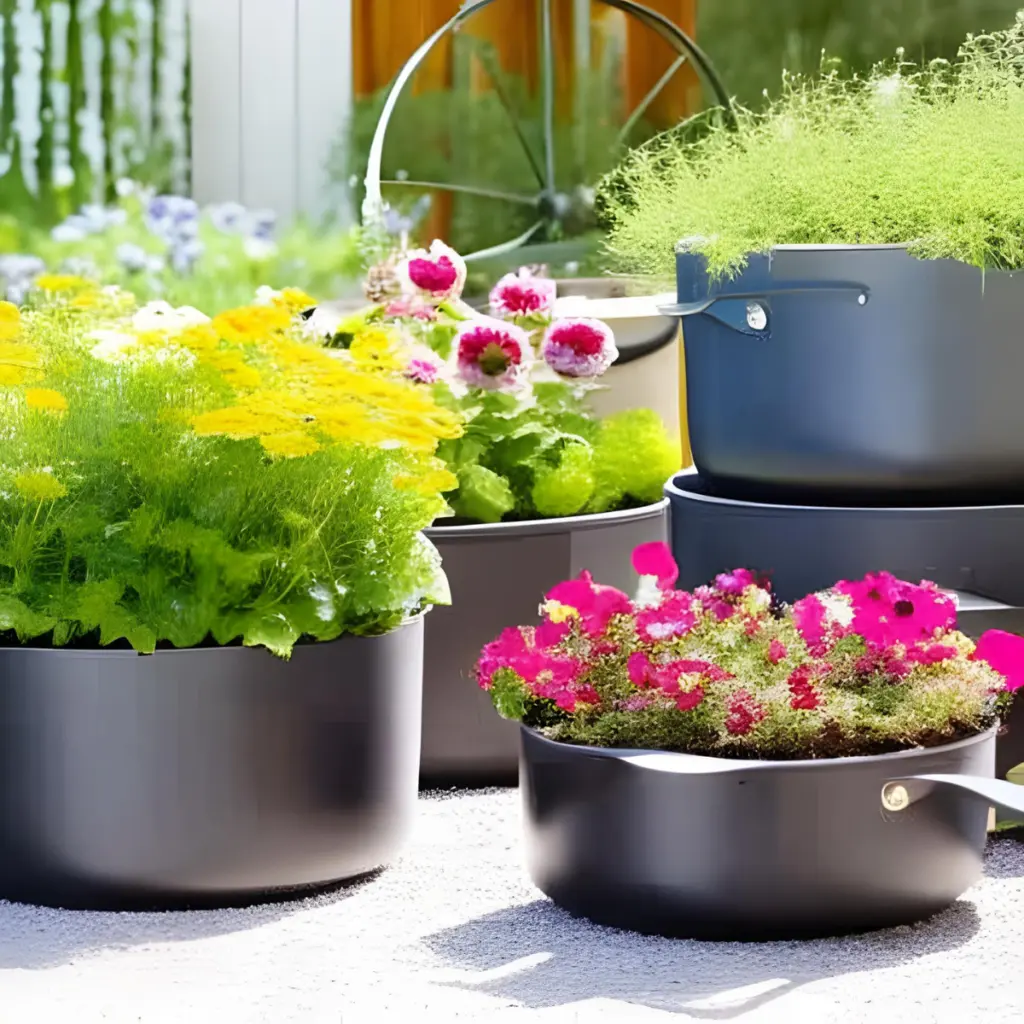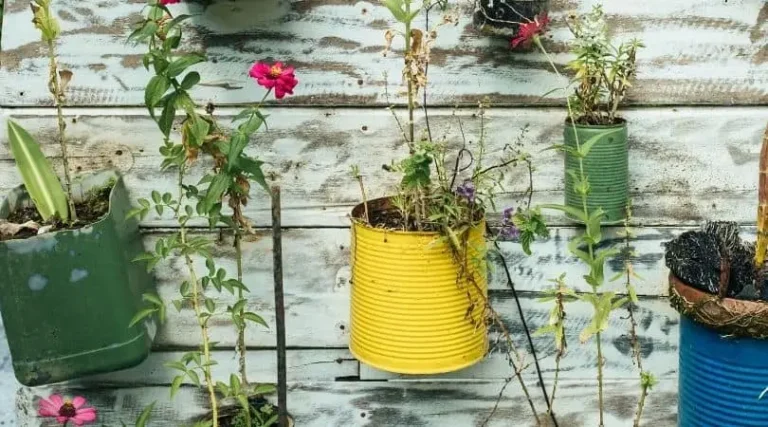Contents
Introduction
Are you looking to add a touch of greenery to your home but don’t want to spend a fortune on fancy plant pots? You’re in luck! Repurposing household items into plant containers is a fantastic way to save money, reduce waste, and show off your creativity. Not only will you give your plants a unique home, but you’ll also make a positive impact on the environment by reusing items that would otherwise end up in the trash.
In this guide, we’re going to walk you through the process of turning everyday items you probably already have lying around the house into stylish and functional plant containers. Whether you’re a seasoned green thumb or just starting your plant journey, this guide will show you how to transform things like plastic bottles, old teacups, and even worn-out boots into charming pots for your plants.
We’ll start by discussing why repurposing is such a great idea and how it benefits both you and the planet. Then, we’ll dive into choosing the right items to repurpose, preparing them for their new role, and providing some fun decorating tips. By the end of this guide, you’ll be ready to give your plants a creative new home and impress your friends with your eco-friendly ingenuity.
So, grab those old cans, jars, and any other items you’ve been holding onto for a rainy day. It’s time to get creative and turn your household cast-offs into beautiful plant containers that will brighten up your home and garden. Ready to dig in? Let’s get started!
Understanding the Basics
So, you’re excited to start turning your old stuff into new plant containers—great choice! But before we dive into the nitty-gritty of repurposing, let’s cover some basics to make sure you’re on the right track.

Why Repurpose?
Environmental Impact: Every year, tons of items end up in landfills, many of which could be given a second life. By repurposing, you’re not only saving those items from the dump but also cutting down on the need for new products, which helps reduce waste and pollution. Plus, recycling and reusing materials lowers your carbon footprint, so you’re doing your bit for the planet.
Cost Efficiency: Buying new plant containers can add up quickly, especially if you’re decorating a whole room or garden. Repurposing items you already have is a wallet-friendly way to create unique and personalized plant pots. Why spend money when you can use what you’ve got?
Creative Expression: One of the best parts about repurposing is that it lets you unleash your creativity. Instead of settling for generic store-bought pots, you can turn everyday objects into one-of-a-kind plant containers that reflect your personal style. It’s a fun way to add character to your home and garden.
Choosing the Right Items
Durability: Not every item is up for the job. You’ll want to pick things that are sturdy enough to hold soil and plants without falling apart. Items made from plastic, metal, or thick glass are usually good candidates. Just make sure they’re strong enough to handle the weight.
Size and Shape: The size and shape of the container can affect your plant’s growth and health. Smaller containers are great for herbs and succulents, while larger ones can house bigger plants. Think about the type of plant you want to grow and choose a container that will give it enough space to thrive.
Drainage Needs: Plants need proper drainage to stay healthy. If your container doesn’t have holes for water to escape, you might end up with soggy soil and root rot. Look for ways to add drainage to your repurposed containers, like drilling holes or using materials that let water flow through.
Understanding these basics will set you up for success as you turn ordinary household items into amazing plant containers. Ready to dive into the fun part? Let’s start preparing those items for their new life as plant pots!
Preparing Household Items for Repurposing
Alright, you’ve got your collection of old bottles, jars, and other potential plant pots ready. Now it’s time to get them ready for their new role. This step is crucial because it ensures your repurposed items are clean, safe, and ready to hold your plants. Let’s break down what you need to do.

Cleaning and Sanitizing
Remove Residue: First things first—your items need a good cleaning. If you’re repurposing food jars or containers, make sure to get rid of any leftover food, sticky labels, or glue. A simple soak in warm, soapy water usually does the trick. For stubborn residues, a scrub brush or a bit of baking soda can help scrub them off. You want your new plant containers to be spotless to avoid any potential issues with mold or pests.
Sanitization: After cleaning, it’s a good idea to sanitize your containers to ensure they’re free of any bacteria or pathogens that could harm your plants. You can use a mix of water and vinegar or a mild bleach solution (about 1 part bleach to 10 parts water). Just make sure to rinse the containers thoroughly after sanitizing to remove any cleaning agents. Let them dry completely before planting to avoid any leftover moisture that could lead to root rot.
Preparing for Drainage
Drilling Holes: Plants need good drainage to stay healthy, so you’ll need to add some holes to your containers if they don’t already have them. This is especially important for items like plastic bottles or tin cans. Use a drill or a sharp tool to carefully make a few small holes in the bottom of your containers. This will let excess water escape and prevent soggy soil.
Alternative Methods: If drilling isn’t an option, you can use other methods to ensure proper drainage. For example, you can place a layer of gravel or small stones at the bottom of your container to help water flow through. Another option is to line the bottom of your container with a piece of mesh or fabric to keep the soil from falling out while still allowing water to drain.
By getting your containers clean, sanitized, and properly equipped for drainage, you’re setting the stage for healthy, happy plants. Now that your items are prepped and ready, it’s time to dive into the fun part: choosing which household items you’re going to turn into plant containers and adding your own creative touch. Let’s get started!
Popular Household Items to Repurpose
Now for the fun part—turning everyday items into stylish and functional plant containers! We’ll walk you through some of the most popular household items you can repurpose, and give you the lowdown on how to prep and plant in each one. Let’s dive in!

Plastic Bottles
Overview: Plastic bottles are incredibly versatile and easy to find. They come in various sizes and shapes, making them a great choice for different types of plants. Whether you have water bottles, soda bottles, or even large jugs, these can be transformed into fantastic plant pots.
Preparation: Start by rinsing out your plastic bottles and removing any labels. Next, cut the bottles to your desired height. You can use the bottom part for larger plants or the top part for smaller ones. Be sure to drill a few holes in the bottom to allow for drainage. If you want to get creative, you can paint the outside or add decorative elements to make them look even more unique.
Planting Tips: Plastic bottles work well for herbs, small flowers, and even small vegetables. Because they are lightweight and portable, they’re great for indoor gardens or patio planters.
Mason Jars
Overview: Mason jars are perfect for adding a bit of vintage charm to your plant display. Their clear glass allows you to see the roots and soil, which can be a fun and attractive feature.
Preparation: Clean the jars thoroughly and remove any labels or sticky residue. To ensure proper drainage, you might need to add a few small stones or gravel at the bottom before adding soil. You can also drill small holes in the metal lid if you’re using it as a cover. If you want to add a touch of color, you can paint the jars or wrap them in decorative paper or fabric.
Planting Tips: Mason jars are ideal for succulents, air plants, or small herbs. They make great mini terrariums or desk plants and can be grouped together for a charming display.
Teacups and Saucers
Overview: Teacups and saucers add a touch of elegance and whimsy to your plant setup. They’re perfect for small plants and can be a great way to upcycle old, mismatched sets.
Preparation: Ensure the teacups and saucers are clean and dry. To make them functional as plant containers, you’ll need to drill a small hole in the bottom of the teacup for drainage. If drilling isn’t an option, you can place a layer of gravel in the bottom of the cup before adding soil. Be cautious with very delicate cups, as they can break easily.
Planting Tips: Teacups are great for tiny plants like succulents, cacti, or small flowering plants. They make charming accents for windowsills or small shelves.
Tin Cans
Overview: Tin cans are robust and come in various sizes, making them a versatile option for plant containers. They can be repurposed from food cans, coffee cans, or even paint cans.
Preparation: Start by removing the labels and cleaning the cans thoroughly. Use a can opener to carefully remove the lid, which will also give you a drainage hole. If you want to prevent rusting, you might consider painting the cans with a rust-resistant paint or adding a protective coating.
Planting Tips: Tin cans are excellent for medium-sized plants, herbs, or even small flowers. They can be painted or decorated to match your home’s decor, making them both practical and stylish.
Wooden Crates and Boxes
Overview: Wooden crates and boxes offer a rustic and charming look. They come in various sizes and can be used for everything from small plants to larger garden setups.
Preparation: Check the wood for any splinters or rough spots and sand them down if needed. To protect the wood from moisture, consider sealing it with a wood sealant or lining the inside with plastic. Drill or punch holes in the bottom for drainage.
Planting Tips: Wooden crates are great for growing a mix of plants, including herbs, flowers, and even small vegetables. They can be used indoors or outdoors and can be stacked or arranged in various configurations for a stylish display.
Old Boots or Shoes
Overview: Old boots or shoes make for quirky and fun plant containers. They’re perfect for adding a bit of personality and whimsy to your plant display.
Preparation: Clean the boots or shoes thoroughly and make sure they’re dry. Drill or poke holes in the bottom for drainage. If the shoes are leather or fabric, you may need to waterproof them or line them with a plastic bag to prevent moisture damage.
Planting Tips: These make excellent containers for small plants, succulents, or even trailing vines. They’re great for adding a touch of character to your garden or indoor plant collection.
Colanders and Strainers
Overview: Colanders and strainers are excellent for their built-in drainage. Their design makes them perfect for plants that need good air circulation and water drainage.
Preparation: Clean the colanders or strainers thoroughly and make sure they’re free of any food residue. You can use them as-is, or you might want to add a decorative touch by painting or lining them with fabric.
Planting Tips: Colanders are perfect for herbs, small flowers, or succulents. They’re especially great for plants that thrive in well-drained soil and need good air circulation.
With these repurposing ideas, you’re all set to turn your household items into stunning plant containers. Each item has its unique charm and functionality, so pick the ones that best suit your style and planting needs. Ready to get planting? Let’s move on to decorating and personalizing your new plant containers!
Creative Decorating Ideas
Now that you’ve got your repurposed containers ready, it’s time to get creative and make them truly your own. Decorating your plant containers not only adds a personal touch but also makes them stand out as unique pieces of decor. Let’s dive into some fun and easy ways to spruce up your plant pots!
Painting and Finishing
Techniques: One of the simplest ways to decorate your containers is by painting them. Choose non-toxic, water-based paints that are safe for both you and your plants. You can use brushes or spray paint to cover the outside of your containers. If you’re going for a classic look, solid colors are always a safe bet. For a bit more flair, try patterns, stripes, or even ombre effects. Just make sure the paint is fully dry before adding soil or plants.
Customization: If painting isn’t your thing, there are other ways to add personality to your containers. Use decorative tape, stencils, or decals to create custom designs. You can also wrap containers in fabric, twine, or ribbon to give them a fresh look. For a rustic feel, try using chalk paint and then distressing it for a vintage touch.
Adding Features
Labels and Tags: Adding labels or tags to your plant containers can be both functional and decorative. Use chalkboard paint to create a writable surface where you can note the plant’s name or care instructions. You can also use metal or wooden tags that can be engraved or written on. Not only does this help you remember what you’ve planted, but it also adds a charming, organized look to your plant display.
Attachments: Get creative by adding extra features to your containers. You can attach handles to make them easier to move or use hooks to create hanging planters. Consider adding small decorative elements like beads, buttons, or mini ornaments to give your containers a unique flair. For a bit of fun, you can even add small fairy lights or LED strips to make your plant pots glow in the evening.
By using these decorating ideas, you can turn your repurposed plant containers into eye-catching pieces that add character and style to your home or garden. Whether you prefer a minimalist look or something more elaborate, the key is to have fun and let your creativity shine. Ready to get started on your next project? Your beautifully decorated plant containers are just a few steps away from being the talk of the town!
Tips for Successful Repurposing
With your repurposed plant containers ready and beautifully decorated, it’s time to ensure your plants thrive in their new homes. Here are some practical tips to help you keep everything in tip-top shape and ensure your plants stay healthy and happy.
Selecting the Right Soil
Choosing Soil: The type of soil you use is crucial for your plants’ health. Most plants prefer well-draining soil that allows water to pass through easily and prevents waterlogging. For most repurposed containers, a general-purpose potting mix works well. However, if you’re growing succulents or cacti, look for a mix specifically designed for these plants, which usually contains extra sand or perlite for better drainage.
Mixing Soil: If you’re unsure about the soil mix, you can create your own by combining equal parts of potting soil, perlite, and compost. This blend ensures good drainage while still providing nutrients for your plants. For containers without drainage holes, you might want to add more perlite or sand to improve soil aeration and prevent root rot.
Watering Considerations
Watering Needs: Different plants have different watering requirements, and your repurposed containers will affect how often you need to water. Containers without drainage holes will retain more moisture, so you might need to water less frequently. For containers with proper drainage, follow the recommended watering schedule for your specific plants, keeping an eye on the soil’s moisture level.
Avoid Overwatering: Overwatering is a common issue, especially with containers that don’t have drainage holes. To prevent this, use a moisture meter or stick your finger into the soil to check for dryness before watering. Make sure to water deeply but infrequently, allowing the soil to dry out between waterings.
Regular Maintenance
Cleaning Containers: Even though you’ve cleaned your containers before planting, it’s a good idea to periodically clean them to prevent the buildup of algae, mold, or pests. For outdoor containers, give them a rinse with water and a gentle brush to remove any debris or dirt. Indoor containers might need less frequent cleaning but keep an eye out for dust or spills.
Checking for Damage: Regularly inspect your containers for any signs of damage or wear. Cracks, rust, or deteriorating materials can affect the health of your plants. For items like tin cans or wooden crates, address any rust spots or splinters promptly to keep the container in good condition. Repair or replace any damaged containers to ensure they continue to support your plants effectively.
By following these tips, you’ll help your repurposed plant containers serve their purpose and keep your plants thriving. With the right soil, proper watering practices, and regular maintenance, your creative plant pots will not only look great but also provide a healthy environment for your green friends. Ready to enjoy your thriving garden? Your plants are on their way to a beautiful, happy home!
Conclusion
You’ve made it to the end of our guide on repurposing household items into plant containers—congratulations! By now, you should be feeling excited and inspired to give new life to those everyday objects you might otherwise toss away. Repurposing isn’t just a creative way to decorate your home or garden; it’s also a fantastic way to make a positive impact on the environment and save a little money along the way.
Recap of Key Points: We’ve covered everything from why repurposing is such a smart choice, to how to prepare your items for planting, and even tips for decorating your containers to match your personal style. Remember, it’s all about turning what you already have into something functional and beautiful for your plants. With a little bit of creativity and effort, you can transform plastic bottles, old jars, teacups, and more into unique and charming plant pots.
Encouragement to Experiment: Don’t be afraid to think outside the box and experiment with different items and decorating techniques. The beauty of repurposing is that there are no hard and fast rules—just your imagination and a bit of DIY spirit. Share your creations with friends and family or on social media to inspire others to try their hand at repurposing.
Additional Resources: If you’re looking for more inspiration or need a bit of guidance, there are plenty of resources available. Check out DIY plant container tutorials online, join gardening forums or social media groups, or visit local gardening clubs for tips and ideas. The gardening community is full of creative people who love to share their experiences and advice.
By embracing the art of repurposing, you’re not only giving household items a second chance but also adding a personal touch to your gardening efforts. So, grab your newly transformed plant containers, get your hands dirty, and enjoy the process of nurturing your plants in their new homes. Happy planting!



